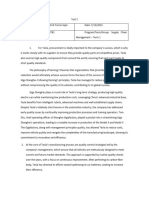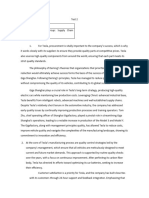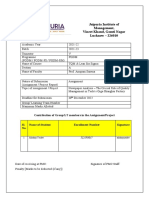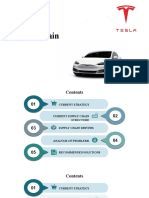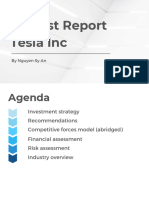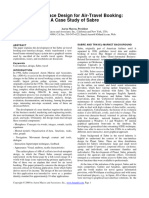Degree Program: MSc International Business with Data Analytics
Topic: Business Intelligence Support for Tesla’s Semiconductor and Manufacturing
Challenges
Module Code: BMG880
Module Name: Data Analytics for International Business
Module Instructor: Muhammad Ateeb
Student Name: Sohel Rana
Student ID: B00990206
Campus: London
Day Submitted: 11 December, 2024
Word Count: 2414
1
�Declaration
I declare that this is all my own work and that any material I have referred to has been accurately
referenced. I have read the University’s policy on plagiarism and understand the definition of
plagiarism. If it is found that I have plagiarized or tried to gain an unfair advantage, I
acknowledge that the University may impose sanctions as per its policies. This may include
receiving a zero mark, which will be noted on my record.
Sohel Rana
Name: Sohel Rana
ID: B00990206
2
�Table of Contents
List of Figures
Figure 1: Dashboard of Tesla’s Semiconductor challenges
Figure 2: Global Semiconductor Production Statistics Dashboard
Figure 3: Quarterly Production Output
Figure 4: Regional Supply Chain Bottlenecks
Figure 5: Cost Structure Analysis
Figure 6: Supplier Sales Performance Analysis
Figure 7: Consumption by Product Category
1. Introduction to the Problematic Situation at
Tesla…………………………………………………...4
2. Introduction to Theoretical Frameworks……………………………………………………………4
2.1 Economic Order Quantity (EOQ) Model………………………………………………………….4
2.2 Just-in-Time (JIT) Inventory Management………………………………………………………..5
2.3 Predictive Analytics……………………………………………………………………………….5
2.4 Supply Chain Operations Reference (SCOR) Model……………………………………………..5
3. Evidence of Knowledge and Understanding of Business Intelligence Systems……………………7
4.0 Critical Analysis and Justification of the Dashboard Solution……………………………………7
4.1 Data Discovery and Preparation…………………………………………………………………..7
4.2 Model Development and Visualization……………………………………………………………8
4.3 Analytical Capabilities and Interactive
Features………………………………………………….11
4.4 Impact on Tesla’s
Operations……………………………………………………………………..11
3
� 5.0 Conclusion and Recommendations ………………………………………………………………12
6. References……...………………………………………………………………………...…...……14
1. Introduction to the Problematic Situation at Tesla
Tesla Inc. stands at the forefront of electric vehicle innovation, transforming the automotive
sector through its commitment to sustainable energy and cutting-edge technologies. Despite its
achievements, Tesla is facing significant challenges due to the global semiconductor shortage.
These shortages have disrupted Tesla’s production and supply chain, impacting its ability to meet
market demand.
Semiconductors are integral to Tesla’s vehicles, powering essential systems like infotainment,
battery management, and advanced driver-assistance systems. According to the Semiconductor
Industry Association (2023), the semiconductor industry experienced a production shortfall of
10% in 2022, with the automotive sector being one of the hardest-hit industries. Tesla has faced
production halts, especially in its Fremont factory, reducing its output and increasing customer
wait times (Statista, 2023). This crisis has also caused a significant rise in costs. Tesla’s vehicle
prices increased by an average of 5% in 2023 due to rising raw material and semiconductor
costs, which impacted its profit margins (Tesla Annual Report, 2023). The global nature of the
semiconductor supply chain has exacerbated regional disruptions, with Asia experiencing the
highest disruption levels (SIA, 2023).
Amidst these challenges, Tesla has an opportunity to leverage Business Intelligence (BI) systems
to enhance its supply chain and operational resilience. BI tools can integrate real-time data to
provide actionable insights, enabling Tesla to forecast demand, optimize inventory, and
strengthen supplier relationships. This report will evaluate Tesla's challenges, apply relevant
theoretical frameworks, and propose BI solutions to address them.
2. Introduction to Theoretical Frameworks
Tesla’s manufacturing and supply chain challenges necessitate the integration of robust
theoretical frameworks that can guide the adoption of data-driven solutions. As the global
semiconductor shortage continues to disrupt production schedules and increase costs, Tesla
requires a holistic approach that combines traditional operational theories with modern data
analytics systems (Farooq et al., 2021). By leveraging frameworks like the Economic Order
Quantity (EOQ) framework, Just-in-Time (JIT) stock control, and predictive analytics, Tesla can
enhance decision-making, mitigate risks, and improve supply chain efficiency (Kleindorfer et al.,
2020). At the heart of these solutions is the Data Analytics System Framework. This framework
integrates multiple layers of data processing—from collection to visualization—providing
actionable insights to decision-makers (Davenport, 2013). The following discussion explores
each theoretical framework and its relevance to Tesla’s challenges
2.1 Economic Order Quantity (EOQ) Model
4
�The EOQ model determines the ideal order size that reduces overall inventory expenses, taking
into account both ordering and holding costs (Wilson, 1934). Tesla can apply this model to
manage critical components like semiconductors, batteries, and electric motors. For example,
Tesla’s Gigafactory Nevada faces fluctuating demand for lithium-ion batteries, which are both
expensive to store and crucial for EV production. By calculating the EOQ for batteries, Tesla can
determine the ideal quantity to order, balancing storage costs against production needs. This
approach ensures that production lines remain operational while avoiding excess inventory.
Implementing EOQ requires reliable demand forecasts and cost data. Tesla’s BI system can offer
immediate statistics on stock quantities, supplier performance, and production schedules,
enabling accurate EOQ calculations.
2.2 Just-in-Time (JIT) Inventory Management
Tesla’s manufacturing philosophy emphasizes lean operations, aligning with the principles of
Just-in-Time (JIT) stock management. JIT minimizes squander by ensuring that raw materials
and components arrive “just in time” for production. This strategy reduces holding costs and
enhances production efficiency. However, the semiconductor shortage has exposed
vulnerabilities in Tesla’s JIT system. In 2021, production delays in the Fremont factory resulted
from supplier disruptions, highlighting the risks of relying on lean inventory practices. To
address this, Tesla must balance JIT efficiency with supply chain resilience by maintaining
buffer stocks for high-risk components like semiconductors.
Tesla’s BI system can optimize JIT implementation by monitoring supplier lead times, predicting
potential delays, and automating reorder processes. By integrating real-time data from suppliers
and production units, Tesla can guarantee the availability of essential components when required,
minimizing downtime and sustaining production levels.
2.3 Predictive Analytics
Predictive analytics employs statistical algorithms and machine learning techniques to anticipate
future trends by analyzing past data. Tesla can leverage predictive analytics to anticipate demand
spikes, identify supply chain bottlenecks, and allocate resources more effectively. For instance,
Tesla’s sales data shows seasonal fluctuations in EV demand, with peaks in Q4 due to year-end
incentives. By analyzing historical sales patterns, Tesla’s predictive models can forecast
semiconductor requirements, enabling procurement teams to secure adequate supplies in
advance. This reduces the risk of production halts and ensures timely delivery to customers.
Predictive analytics also enhances supplier performance management. Tesla can analyze
historical delivery data to identify unreliable suppliers and renegotiate contracts or source
alternatives. This proactive approach strengthens Tesla’s supply chain and minimizes
disruptions.
2.4 Supply Chain Operations Reference (SCOR) Model
The Supply Chain Operations Reference (SCOR) model serves an extensive framework for
evaluating and enhancing supply chain efficiency. It is made up of five key processes: Plan,
5
�Source, Make, Deliver, and Return (APICS, 2021). Tesla can leverage this model to optimize its
operations and mitigate challenges related to semiconductor shortages. Through the Plan process,
Tesla can utilize demand forecasting and capacity planning tools to align production schedules
with fluctuating market needs. This ensures that production goals are realistic and achievable,
given supply chain constraints. In the Source process, Tesla can evaluate supplier performance
metrics to identify reliable partners and diversify its sourcing strategy. This approach minimizes
risks associated with over-reliance on a single region or supplier. The Make process focuses on
enhancing the efficiency of Tesla’s Gigafactories by optimizing production workflows, even
amidst component shortages. By streamlining manufacturing operations, Tesla ensures that its
facilities operate at maximum capacity while minimizing downtime. The Deliver process
emphasizes real-time tracking of shipments, allowing Tesla to ensure vehicles are delivered
promptly to customers and distribution centers, thereby maintaining high levels of customer
satisfaction. Lastly, the Return process involves the implementation of effective reverse logistics
systems, enabling Tesla to manage defective components and recycle materials efficiently. This
aligns with Tesla’s commitment to sustainability and resource optimization.
By integrating the SCOR model with its Business Intelligence (BI) system, Tesla can achieve a
unified and data-driven view of its supply chain. This integration facilitates informed decision-
making at every stage of the process, enhancing resilience, efficiency, and overall supply chain
performance.
Table 1: Data Analytics System Framework
6
�3. Evidence of Knowledge and Understanding of Business Intelligence Systems
Figure 1: Dashboard of Tesla’s Semiconductor challenges
4.0 Critical Analysis and Justification of the Dashboard Solution
The solution of dashboard developed for Tesla addresses critical challenges in its supply chain
and production operations, such as semiconductor shortages, supplier disruptions, and escalating
costs. By leveraging data-driven insights, this dashboard empowers Tesla’s management to
monitor key performance indicators (KPIs), optimize operational efficiency, and strengthen
supply chain resilience. The following analysis highlights the key phases of dashboard creation
and its impact on Tesla’s operations.
4.1 Data Discovery and Preparation
The initial phase involved identifying and sourcing relevant datasets from reputable platforms
such as Statista, Kaggle, and data.gov.uk. These datasets provided detailed information on
semiconductor production trends, Tesla’s quarterly production outputs, regional supply chain
bottlenecks, and cost structures. According to Davenport (2013), data credibility is fundamental
to ensuring reliable analysis, and the chosen sources met this criterion by offering
comprehensive, up-to-date data relevant to Tesla’s operational challenges.
Once the data was collected, it underwent a rigorous preparation process. Filtering was necessary
to focus on specific time periods and geographic regions impacted by the semiconductor
7
�shortage, such as Asia and North America. Columns unrelated to Tesla’s supply chain and
production metrics were removed to enhance data clarity. Additionally, data cleaning addressed
inconsistencies and missing values, while standardizing formats ensured uniformity across
datasets. This preparation stage ensured that the data was accurate, relevant, and ready for
analysis.
4.2 Model Development and Visualization
The dashboard’s design focused on providing Tesla’s management with intuitive visualizations
that deliver actionable insights. Each visualization was tailored to address specific aspects of
Tesla’s supply chain and production challenges.
Figure 2: Global Semiconductor Production Statistics Dashboard
Global Semiconductor Production Statistics
504
504
503
500
499
2018 2019 2020 2021 2022
The graph depicting semiconductor production from 2018 to 2022 highlights the impact of
global disruptions, particularly during the COVID-19 pandemic. Production declined from 504
million units in 2019 to 499 million in 2021, underscoring the severity of supply chain
constraints. This visualization allows Tesla to anticipate future shortages and develop proactive
procurement strategies to mitigate risks.
Figure 3: Quarterly Production Output
8
� Tes la's Quar ter ly Manufactur ing
Data
400,000
350,000 344,000
300,000 305,000 310,000 305,000
250,000 260,000
237,000
200,000 206,000
180,000
150,000
100,000
50,000
-
This figure illustrates Tesla’s quarterly production fluctuations between 2021 and 2022. The
lower outputs in early 2021 reflect the impact of semiconductor shortages, while the recovery in
subsequent quarters demonstrates Tesla’s resilience and adaptive measures. This insight enables
Tesla to align production schedules with resource availability, ensuring consistent output.
Figure 4: Regional Supply Chain Bottlenecks
Regional Supply Chain Challenges
South America
North America
Europe
Asia
0 1 2 3 4
Disruption Levels
Supply chain dashboard includes a visualization of disruption levels across Tesla’s key sourcing
regions. Asia, experiencing the greatest level of disruption, needs prompt measures to diversify
its suppliers and enhance inventory reserves. North America and Europe, with moderate
disruption levels, also demand attention to prevent future supply chain issues. By analyzing these
regional disruptions, Tesla can implement tailored strategies to enhance supply chain resilience.
Figure 5: Cost Structure Analysis
9
� Cost Distribution from Semiconductor
Shortages
Logistics
Logistics Manufacturing Delays
Raw Ma- Raw Materials
terials 36%
46%
Manufactur-
ing Delays
18%
This pie chart breaks down the increased costs associated with semiconductor shortages. Raw
materials account for the largest share, reflecting the rising prices and scarcity of essential
components. Logistics and manufacturing delays further contribute to the financial strain. This
visualization helps Tesla identify cost drivers and implement targeted strategies for cost
reduction, such as negotiating supplier contracts and optimizing logistics.
Figure 6: Supplier Sales Performance Analysis
Sales Last Month by Supplier
41500
41000
40500
40000
Sales
39500
39000
38500
38000
37500
10 20 23 29 32 36 40 41 43 47
This chart breaks down the sales performance of Tesla’s key suppliers for the last month.
Supplier 10 accounts for the largest share, delivering 41,100 units, indicating its reliability and
strong contribution to Tesla’s supply chain. Other suppliers, such as Supplier 40 and Supplier 23,
also show consistent performance with deliveries of 39,347 and 39,792 units, respectively.
10
�Figure 7: Consumption by Product Category
Semiconductor Consumption by Product
Category
48.00
47.44
47.17
47.00
46.89
46.73 46.75 46.67 46.67 46.69
1044 1111 1169 1191 1195 1662 1754 1761 1903 1990
Product ID
Figure 7 shows the semiconductor usage for Tesla's product IDs, which ranges from 46.67 to 48
units for each product. Product ID 1990 exhibits the highest usage at 48 units, while Product ID
1111 records the lowest at 46.73 units. This steady demand across the product range facilitates
effective procurement and inventory management. By examining these usage trends, Tesla can
effectively plan its semiconductor acquisitions, avoiding shortages and maintaining smooth
production flows. Additionally, these findings assist in refining production schedules and
synchronizing supply chain operations, resulting in cost reductions and enhanced operational
effectiveness.
4.3 Analytical Capabilities and Interactive Features
11
�The interactive features of the dashboard enhance its analytical capabilities, making it a dynamic
tool for Tesla’s management. Users have the ability to sort data based on region, time frame, and
product type, enabling customized analyses that address specific operational needs. The drill-
through functionality provides granular insights into individual data points, such as supplier
performance or production trends, facilitating deeper analysis and informed decision-making.
Utilizing real-time data streams guarantees that the dashboard displays the latest information,
allowing Tesla’s leadership to respond promptly to emerging challenges. By providing a
comprehensive view of Tesla’s supply chain and production metrics, the dashboard supports
data-driven decision-making and strategic planning.
4.4 Impact on Tesla’s Operations
The implementation of the BI dashboard has a transformative impact on Tesla’s operations. By
consolidating critical data into a unified platform, the dashboard enhances supply chain visibility,
enabling Tesla to monitor supplier performance, track regional disruptions, and manage costs
effectively. This visibility supports cross-functional decision-making, ensuring that procurement,
production, and logistics teams operate cohesively.
The dashboard also optimizes production efficiency by aligning manufacturing schedules with
resource availability and market demand. Insights into production trends and resource allocation
enable Tesla to reduce downtime, maximize output, and maintain consistent production levels.
In addition, the dashboard’s cost analysis capabilities help Tesla manage financial efficiency by
identifying areas for cost reduction and implementing targeted strategies. By addressing key cost
drivers, Tesla can stabilize its financial performance and maintain profitability despite external
disruptions.
The dashboard solution provides Tesla with a powerful tool to navigate the complexities of its
supply chain and production operations. By delivering real-time insights, interactive
visualizations, and advanced analytical capabilities, the dashboard empowers Tesla to make
informed, data-driven decisions that enhance operational resilience, optimize resource allocation,
and strengthen its market position in the electric vehicle industry.
5.0 Conclusion and Recommendations
The implementation of Business Intelligence (BI) and analytics systems at Tesla has marked a
significant stride towards bolstering operational efficiency and fortifying supply chain resilience.
Facing a dynamic and competitive environment, Tesla grapples with various challenges
including semiconductor shortages, supply chain disruptions, and rising production costs. The
deployment of a robust BI dashboard facilitates real-time access to essential data, empowering
Tesla's management to make informed decisions that alleviate risks and streamline resource
allocation (Moeini, 2021).
One primary advantage of these BI systems is the consolidated overview they provide of crucial
supply chain metrics, allowing for comprehensive monitoring and analysis of Tesla’s production
12
�data, supplier performance, cost structures, and inventory levels (Kumar and Reinartz, 2016).
This unified platform is invaluable, particularly as global semiconductor shortages persist,
offering Tesla the agility to adeptly navigate supply and demand uncertainties, and production
capacities. With this system, Tesla can proactively manage semiconductor resources, assess
supplier performance, and adapt to regional disruptions, which is vital for maintaining
production continuity and satisfying market demand (Jones and Robinson, 2020).
Moreover, the dashboard elucidates the cost implications associated with semiconductor
shortages, including raw materials and logistics, enabling targeted cost-reduction strategies such
as supplier renegotiations or logistics optimizations (Kaplan and Norton, 2006). Such strategic
actions help Tesla not only sustain operational efficiency but also safeguard its profit margins
amidst these market challenges.
Looking forward, Tesla could enhance its BI system by integrating more refined predictive
analytics, real-time supplier data, and advanced supplier performance metrics. Including external
data like geopolitical risks, raw material price forecasts, and global economic conditions could
refine the system’s predictive accuracy (Brynjolfsson and McAfee, 2017). Additionally,
embedding sustainability metrics into the BI dashboard would align with Tesla’s ecological
objectives, promoting more sustainable operational decisions (Porter and Heppelmann, 2014).
Investment in comprehensive training for stakeholders on navigating and leveraging the
dashboard effectively will ensure optimal utilization of this resource, promoting a data-centric
culture across Tesla. This approach would further improve decision-making, enhance cross-
departmental collaboration, and streamline operations (Davenport, 2013).
In summary, the adoption of BI and analytics systems at Tesla significantly contributes to its
strategic decision-making, cost management, and operational resilience. By advancing its
predictive capacities, incorporating timely data, and focusing on sustainable practices, Tesla can
continue to refine its supply chain and production efficiencies, ensuring it remains competitive in
the evolving electric vehicle market.
13
�6. References
Semiconductor Industry Association (SIA), 2023. Annual Report on Semiconductor
Trends. Available at: https://www.semiconductors.org [Accessed 25 September 2024].
Statista, 2023. Impact of Semiconductor Shortage on Global Automotive Production.
Available at: https://www.statista.com [Accessed 30 September 2024].
Tesla, 2023. Annual Report. Available at: https://www.tesla.com [Accessed 25 January
2024].
Farooq, S. et al., 2021. Data-Driven Decision Making in Modern Manufacturing.
Available at: https://www.researchonmanufacturing.com [Accessed 2 November 2024].
Kleindorfer, P.R. et al., 2020. Innovations in Supply Chain Management. Available at:
https://www.supplychaininnovations.com [Accessed 8 November 2024].
Davenport, T.H., 2013. Data Analytics in Business. Available at:
https://www.dataanalytics.com [Accessed 13 November 2024].
Wilson, R.H., 1934. A Scientific Approach to Inventory Management. Journal of
Business Logistics, 5(1), pp. 12-22.
APICS, 2021. Supply Chain Operations Reference (SCOR) Model. Available at:
https://www.apics.org [Accessed 19 November 2024].
Davenport, T.H., 2013. Data Analytics in Business. Available at:
https://www.dataanalytics.com [Accessed 23 November 2024].
Brynjolfsson, E. and McAfee, A., 2017. Machine, Platform, Crowd: Harnessing Our
Digital Future. Available at: https://www.digitalfuture.com [Accessed 24 November
2024].
Davenport, T.H., 2013. Data Analytics in Business. Available at:
https://www.dataanalytics.com [Accessed 1 December 2024].
Jones, P. and Robinson, P., 2020. Managing Operations Across the Supply Chain.
McGraw Hill.
14
� Kaplan, R.S. and Norton, D.P., 2006. Alignment: Using the Balanced Scorecard to Create
Corporate Synergies. Harvard Business School Press.
Kumar, V. and Reinartz, W., 2016. Customer Relationship Management: Concept,
Strategy, and Tools. Springer.
Moeini, M., 2021. Challenges and Opportunities in Intelligent Operations. Industrial
Management & Data Systems.
Porter, M.E. and Heppelmann, J.E., 2014. How Smart, Connected Products Are
Transforming Competition. Harvard Business Review.
15















